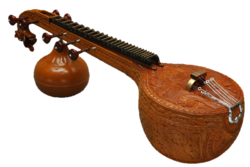Saraswati veena

Saraswati veena
|
|
| String instrument | |
|---|---|
| Other names | Saraswati guitar |
| Classification | string |
| Musicians | |
| Veenai Dhanammal, Sundaram Balachander, Chitti Babu, Kalpakam Swaminathan, E. Gayathri, Rajhesh Vaidhya, Jayanthi Kumaresh | |
| More articles | |
| Rudra veena, Vichitra veena, Chitra veena | |
The Sarasvati vīṇa (also spelled Saraswati vina) ( Tamil: வீணை, Bengali: সরস্বতী বীণা , Sanskrit: वीणा (vīṇā), Kannada: ವೀಣೆ, Malayalam: വീണ, Telugu: వీణ) is an Indian plucked string instrument. It is named after the Hindu goddess Saraswati, who is usually depicted holding or playing the instrument. Also known as raghunatha veena is used mostly in Carnatic Indian classical music. There are several variations of the veena, which in its South Indian form is a member of the lute family. One who plays the veena is referred to as a vainika.
It is one of other major types of veena popular today. The others include chitra veena, vichitra veena and rudra veena. Out of these the rudra and vichitra veenas are used in Hindustani music, while the Saraswati veena and the chitra veena are used in the Carnatic music of South India. Some people play traditional music, others play contemporary music.
The veena has a recorded history that dates back to the approximately 1500 BCE.
In ancient times, the tone vibrating from the hunter's bow string when he shot an arrow was known as the Vil Yazh. The Jya ghosha (musical sound of the bow string) is referred to in the ancient Atharvaveda. Eventually, the archer's bow paved the way for the musical bow. Twisted bark, strands of grass and grass root, vegetable fibre and animal gut were used to create the first strings. Over the veena's evolution and modifications, more particular names were used to help distinguish the instruments that followed. The word veena in India was a term originally used to generally denote "stringed instrument", and included many variations that would be either plucked, bowed or struck for sound.
...
Wikipedia
